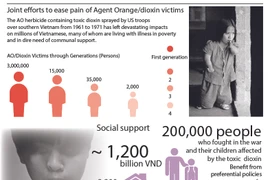 The workshop on November 13 looks into the outcomes of the trial remediation of dioxin using microbial technology at A Sho airfield (Photo: moitruong24h.vn)
The workshop on November 13 looks into the outcomes of the trial remediation of dioxin using microbial technology at A Sho airfield (Photo: moitruong24h.vn)Thua Thien-Hue (VNA) – A workshop was held inthe central province of Thua Thien-Hue on November 13 to look into the outcomesof the trial remediation of dioxin using microbial technology at A Sho airfieldin A Luoi district.
The event was organised by the VietnamAssociation for Conservation of Nature and Environment (VACNE), the Republic ofKorea’s BJC company, and the A Luoi district People’s Committee.
VACNE and BJC experts shared the view that thetrial remediation was carried out in line with the process, met technicalstandards for biological treatment, and matched local conditions.
Biotechnology is relatively simple technologywith low cost, high feasibility and considerable effects in dioxin contaminatedland, they noted.
The VACNE and Korean partners like BJC, KIT andKIOST have assisted A Luoi district to pilot remediating dioxin-polluted landof A Sho airfield over the past years.
On this occasion, the VACNE and BJC presentedgift packages to more than 30 families with Agent Orange/dioxin victims. Theyalso supported A Luoi district with 60 million VND (over 2,600 USD) to helpbuild a relic site showing chemical war remnants.
The US army sprayed some 80 million litres oftoxic chemicals from 1961 to 1971, 61 percent of which was Agent Orangecontaining 366 kilograms of dioxin, over nearly one quarter of the total areaof South Vietnam.
Preliminary statistics showed that 4.8 millionVietnamese people were exposed to Agent Orange/dioxin, and about 3 millionpeople became victims. Tens of thousands of people have died while millions ofothers have suffered from cancer and other incurable diseases as a result. Manyof their offspring have also suffered from birth deformities.-VNA





























